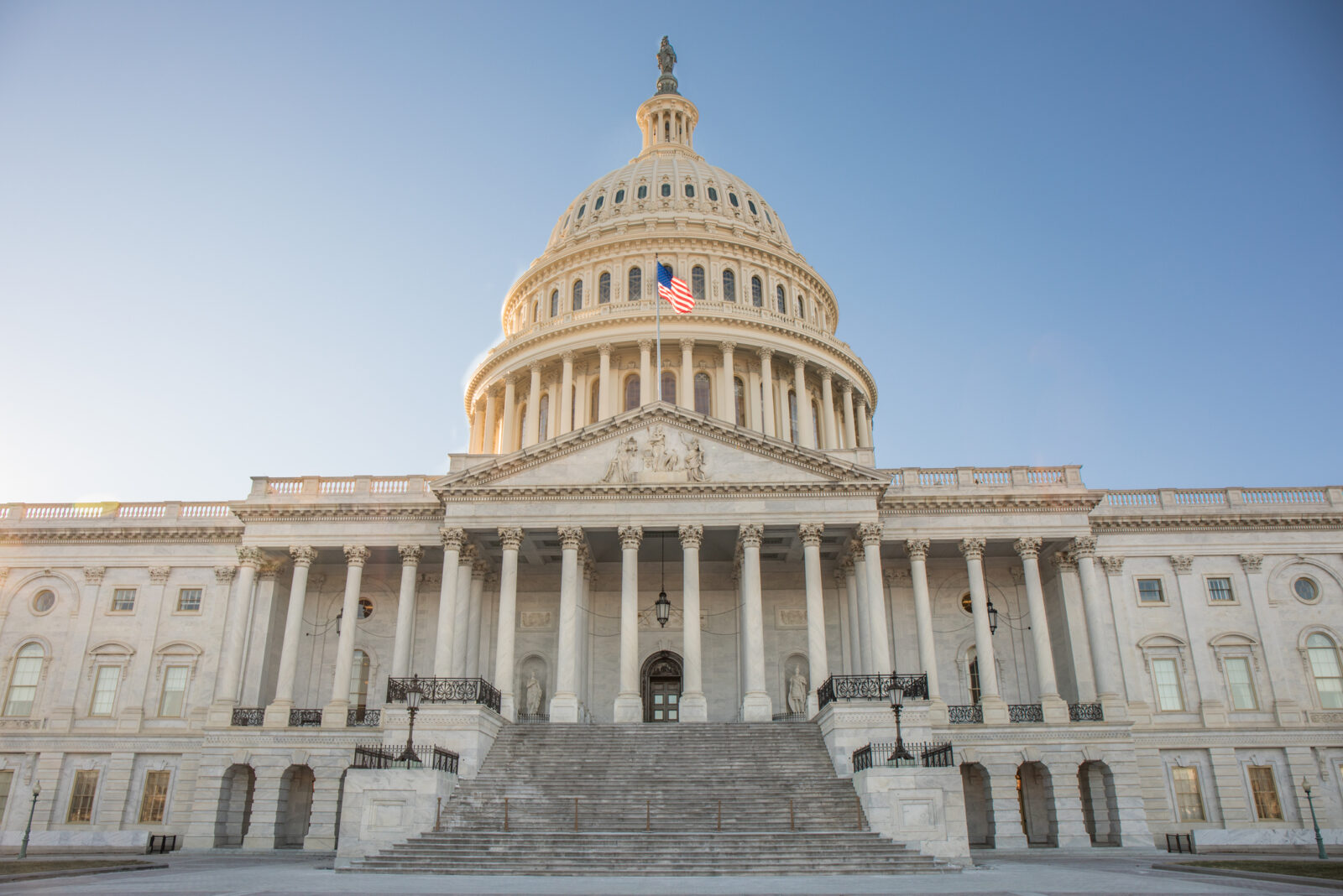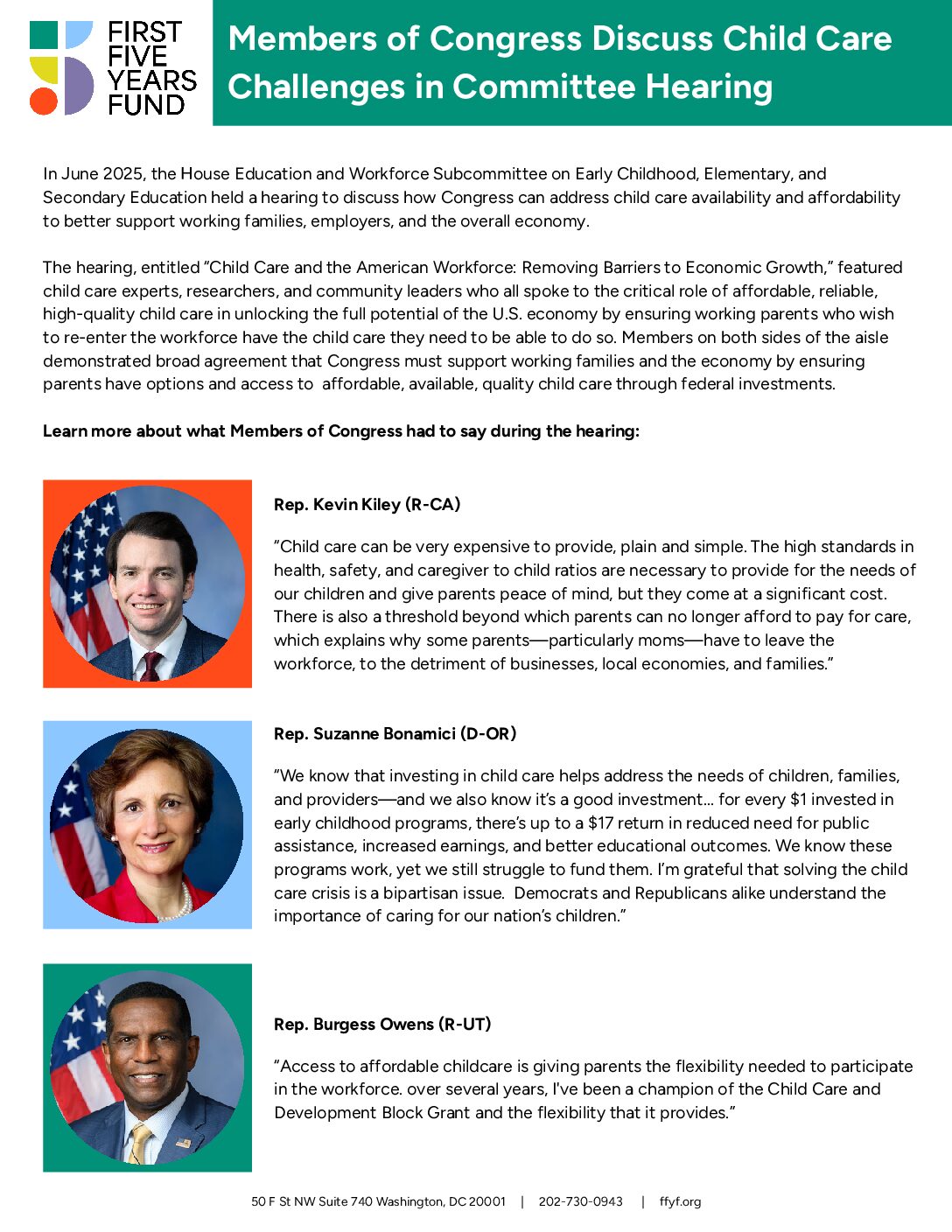House Education and Workforce Hearing Highlights Overwhelming Bipartisan Agreement that Child Care is Key to a Robust Economy

The House Education and Workforce Subcommittee on Early Childhood, Elementary, and Secondary Education held a hearing this week to discuss how Congress can address child care availability and affordability to better support working families, employers, and the overall economy.
The hearing, entitled “Child Care and the American Workforce: Removing Barriers to Economic Growth,” featured child care experts, researchers, and community leaders who all spoke to the critical role of affordable, reliable, high-quality child care in unlocking the full potential of the U.S. economy by ensuring working parents who wish to re-enter the workforce have the child care they need to be able to do so. Members on both sides of the aisle demonstrated broad agreement that Congress must support working families and the economy by ensuring parents have options and access to affordable, available, quality child care through federal investments, including the Child Care and Development Block Grant (CCDBG), the Child and Dependent Care Tax Credit (CDCTC), and more.
Key topics highlighted by Members on both sides of the aisle included:
- Updating and investing more into federal programs and tax credits like CCDBG and CDCTC;
- Workforce challenges faced by providers in the child care industry;
- Unique child care challenges faced by rural communities;
- Importance of parental choice in early learning and the flexibility for parents offered by federal programs;
- Child care is a challenge in every Congressional district, and there is bipartisan commitment to enacting solutions
Witnesses included:
- Mrs. Caitlin Codella Low, Managing Director of Human Capital, Bipartisan Policy Center
- The Honorable Todd D. Barton, Mayor, City of Crawfordsville
- Dr. Ruth Friedman, Senior Fellow, The Century Foundation
- Ms. Celia Hartman Sims, President and Founder, The Abecedarian Group
In his opening statement, Chairman Kevin Kiley (R-CA) emphasized that child care is essential to families and the economy, and highlighted the Child Care and Development Block Grant (CCDBG) program as the primary way the federal government can provide support to working families who cannot access child care due to its growing, unsustainable cost. Congressman Kiley highlighted the complex nature of the problem, noting, “Child care can be very expensive to provide, plain and simple. The high standards in health, safety, and caregiver to child ratios are necessary to provide for the needs of our children and give parents peace of mind, but they come at a significant cost. There is also a threshold beyond which parents can no longer afford to pay for care, which explains why some parents—particularly moms—have to leave the workforce, to the detriment of businesses, local economies, and families.”
Congressman Kiley discussed how CCDBG tackles the problem by providing families with the support they need to access child care, “giving parents the freedom to remain in the workforce and increase their economic opportunity.” He also underscored that “choice is a pillar of the program, giving parents the freedom to make both lifestyle and economic decisions that best meet their individual family’s needs.” Congressman Kiley emphasized how CCDBG helps “low-income families move beyond the need for a federal safety net and thrive independent of government support,” concluding that “together, families, businesses, and our communities see boosted economic growth as a result.”
In her opening remarks, Ranking Member Suzanne Bonamici (D-OR) reinforced that the cost of child care forces parents out of the workforce, emphasized the challenges child care providers face in terms of low compensation and scant benefits, and echoed Chairman Kiley’s sentiment that federal investments in programs like CCDBG are critical to addressing the crisis of child care access and affordability. Congresswoman Bonamici underscored how far such investments go, citing Mrs. Codella Low’s testimony that “for every $1 invested in early childhood programs, there is up to a $17 return in reduced need for public assistance, increased earnings, and better educational outcomes.”
Additionally, Congresswoman Bonamici pointed out the unique challenges rural communities face in the child care market and the important role of federal programs in bridging those gaps. She stated, “This issue is especially acute in my home state of Oregon, where the hurdles are both supply and affordability… Earlier this year, I held a town hall meeting in Clatskanie, which is a rural city of about 1700 people, very rural, where the Head Start center is the only child care available in the entire city. And on Oregon’s coast, limited options for child care prevent the coastal towns from expanding and thriving when families have to turn down jobs here because there is no child care available.”
Congresswoman Bonamici also highlighted the robust bipartisan support behind solutions, adding “I’m grateful that solving the child care crisis is a bipartisan issue. Democrats and Republicans alike understand the importance of caring for our nation’s children. We have bipartisan support for a $12.4 billion investment in the Child Care and Development Block Grant.”
During the Q&A portion of the hearing, Members continued to highlight the broad bipartisan recognition of the problem, as well as efforts they champion to work across the aisle to address it by improving, updating, and investing more into federal programs.
Congressman Burgess Owens (R-UT) stated that as a “champion of the Child Care and Development Block Grant and the flexibility that it provides,” he looks forward to “understanding how better to leverage our policy and support our parents and children.” Delegate James Moylan (R-Guam) also emphasized the importance of CCDBG and the need to strengthen the program, underscoring that “access to high quality affordable child care is important to many parents and provides the flexibility needed to participate in the workforce,” and yet for families in Guam, CCDBG vouchers are limited and “hard to receive because the threshold is so low… at $62,711.84” for double-income households to qualify. Similarly, Congresswoman Summer Lee (D-PA) emphasized the need for more federal investment in child care, as programs like CCDBG do not currently reach all eligible children, noting, “In my district, less than a third of eligible children receive the child care assistance they qualify for. That’s nearly 7,000 children who cannot afford care and cannot access the subsidies they’re entitled to.”
Congressman Ryan Mackenzie (R-PA) expressed agreement that “there is broad bipartisan recognition of the problem families have in accessing quality and affordable child care, and the barrier that creates for people going back into the workforce,” and that Congress has opportunities to increase federal investment. He highlighted his bipartisan legislation co-led with Congresswoman Sharice Davids (D-KS), the Affordable Child Care Act, “which would expand the Child and Dependent Care Tax Credit so parents can afford a broader range of child care options.”
Members also highlighted the workforce challenges faced by providers in the child care industry. Congresswoman Suzanne Bonamici (D-OR) noted that “despite the high cost of child care, providers are also struggling… Child care workers are among the lowest paid sectors and many child care providers have little or no access to other workplace benefits like health care. It’s unacceptable that the people who are caring for our nation’s youngest barely make a living wage, and have stability in their own lives.” Congressman Ryan Mackenzie (R-PA) agreed that Congress must act to address “the challenges that providers face and increasing supply of child care providers, not only in terms of the facilities, but also the workers… making sure that they’re earning a wage that they can actually sustain their own families in these roles.”
Several Members also echoed Congresswoman Bonamici’s points about the unique child care challenges faced by rural communities in terms of economies of scale and limited supply. Congressman G.T. Thompson discussed the barriers to entry to the market he has seen “as someone who represents a third of the landmass of Pennsylvania – very rural counties, 18 counties,” pointing out that “there are kids that we need child care for, but are there enough kids for someone in order to be able to…successfully and financially put together a child care operation that works?” Congressman Mark Harris (R-NC) agreed, “As a Representative of a largely rural district myself, I’ve also seen firsthand the outsized effects that accessible child care can have on rural communities.” He asked Mayor Barton about the role the federal government should play in the child care crisis, who answered that “the current system, the CCDBG funding with its focus on vouchers – that’s fantastic.” He noted, “it’s going to take a combination of federal spending, and federal focus, along with states, local governments and businesses.” Delegate James Moylan (R-Guam) noted to Mayor Barton, “your city is similar in size to some of Guam’s villages,” and agreed that “operating a child care business is not economically feasible in smaller communities.” Delegate Moylan highlighted the importance of the flexibility of federal programs in addressing these challenges across diverse communities, noting that “I think it’s important to remember that although we are one nation, we have many cultures in our country – that’s especially true in places like the U.S. territories,” and underscoring that the parental choice offered in programs like CCDBG is paramount to supporting all communities.
Another point of agreement among Members raised during the hearing was the strength of federal programs in offering flexibility and choice, providing families with the freedom to make the child care decisions that work best for them – be it home-based, faith-based, or center-based care. Witness Celia Hartman Sims echoed Chairman Kiley’s opening point that “respecting parent choice in child care is the core tenet of the federal Child Care and Development Block Grant.” Congressman Bobby Scott (D-VA) noted that “faith-based providers have always been a major participant in child care programs, including Head Start and CCDBG.” Witness Ruth Friedman agreed, “I think it is really important that there are a lot of choices in the child care market for families to choose between. It is a very personal decision, where you put your baby while you are at work. …For some, the smaller size of a family child care feels much more comfortable; for others, they really liked the structure of a center. And I think it is really important that our child care policies support all of these different models so that parents continue to have those choices.” Chairman Kiley concluded in his closing statement that the mixed delivery model of federal programs is their greatest strength, stating that “choice and flexibility must remain the central pillars of the system.”
Overall, Members on both sides of the aisle highlighted the challenges their constituents face in finding and affording child care, in every Congressional district, and expressed commitment to working together to bring families relief. As Congresswoman Mary Miller (R-IL) stated, “In my district, the median household income is just over $70,000 and child care costs between $8,000 and $10,000 per child. In many cases, the average income can’t sustain two children and child care. It’s just not feasible …. Ultimately, our goal should be to make child care so affordable that parents don’t have to decide between caring for their children or working multiple jobs.”
Full testimony and video of the hearing can be found here.
Explore the document below to find quotes from Members of Congress during the hearing:
Subscribe to FFYF First Look
Every morning, FFYF reports on the latest child care & early learning news from across the country. Subscribe and take 5 minutes to know what's happening in early childhood education.




